Select Device Instinct sensor, made by Abbott, for MiniMed 780G Freestyle Lingo Freestyle Libre 3 Freestyle Libre 2 Freestyle Libre 14 Day Dexcom G7 Dexcom G6 Dexcom Stelo Guardian Connect Medtronic Simplera Medtronic Simplera Sync Eversense Meter Omnipod Omnipod Dash Medtronic 780G Medtronic 630G Tandem t:slim X2 Bigfoot Unity Medtronic InPen Tempo Pen NovoPen 6/NovoPen Echo Insulin Pen Afrezza CeQur Simplicity Patch V-Go Patch Omnipod GO Patch Syringe and Vial Beta Bionics iLet Pancreas Control IQ with Dexcom Control IQ with Freestyle Libre Minimed 780G with Smart Guard Omnipod 5 Tandem Mobi Tidepool Loop twiist DIY Loop Apple Series 6/7/8/9/10/SE (2nd Generation) Garmin vívosmart 5™ Garmin Venu Sq 2 Garmin Venu 3 Garmin vivoactive 5 Garmin Fenix 8 Garmin vivofit jr 3 Garmin Forerunner 165/265/965 Garmin epix (Gen 2) Garmin Enduro 3 Fitbit Ace LTE Fitbit Charge 6 Fitbit Inspire 3 Fitbit Versa/Versa 2/4/Versa Lite Fitbit Sense 2 Fitbit Luxe Google Pixel 2/3 Samsung Galaxy 4/5 Xiaomi Mi Band 9 Oura Ring Whoop 4.0 Withings ScanWatch 2 Withings ScanWatch Lite Pedometer 3D Pedometer
Select Device Instinct sensor, made by Abbott, for MiniMed 780G Freestyle Lingo Freestyle Libre 3 Freestyle Libre 2 Freestyle Libre 14 Day Dexcom G7 Dexcom G6 Dexcom Stelo Guardian Connect Medtronic Simplera Medtronic Simplera Sync Eversense Meter Omnipod Omnipod Dash Medtronic 780G Medtronic 630G Tandem t:slim X2 Bigfoot Unity Medtronic InPen Tempo Pen NovoPen 6/NovoPen Echo Insulin Pen Afrezza CeQur Simplicity Patch V-Go Patch Omnipod GO Patch Syringe and Vial Beta Bionics iLet Pancreas Control IQ with Dexcom Control IQ with Freestyle Libre Minimed 780G with Smart Guard Omnipod 5 Tandem Mobi Tidepool Loop twiist DIY Loop Apple Series 6/7/8/9/10/SE (2nd Generation) Garmin vívosmart 5™ Garmin Venu Sq 2 Garmin Venu 3 Garmin vivoactive 5 Garmin Fenix 8 Garmin vivofit jr 3 Garmin Forerunner 165/265/965 Garmin epix (Gen 2) Garmin Enduro 3 Fitbit Ace LTE Fitbit Charge 6 Fitbit Inspire 3 Fitbit Versa/Versa 2/4/Versa Lite Fitbit Sense 2 Fitbit Luxe Google Pixel 2/3 Samsung Galaxy 4/5 Xiaomi Mi Band 9 Oura Ring Whoop 4.0 Withings ScanWatch 2 Withings ScanWatch Lite Pedometer 3D Pedometer

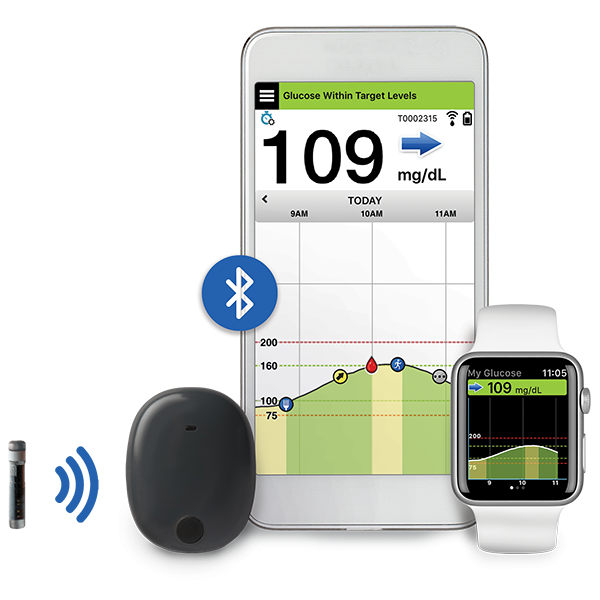
Summary
The InPen system enhances management with multiple daily injections because it tracks data in real-time and offers personalized dosing recommendations. This system combines the Guardian Connect CGM with smart insulin pens for more time in range.
This sensor lasts the longest - 365 days. It has to be placed under the skin by a healthcare provider. It has two parts, the implantable sensor and a transmitter that sends data to a mobile device.
MARD: 8.5-9.1%
*Recently FDA approved for use with insulin pumps.
Components
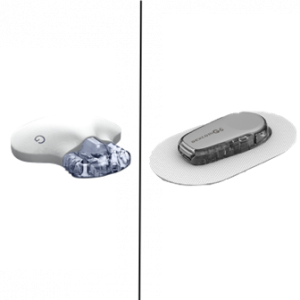
Medtronic InPen : Sensor
Sensor is inserted underneath the skin, either on the abdomen or arm. InPen is compatible with the Medtronic Guardian Connect sensor (left) or the Dexcom G6 sensor (right).
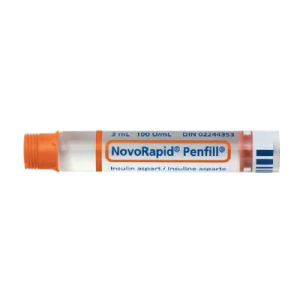
Medtronic InPen : Cartridge
InPen is compatible with Humalog, Novolog, and Fiasp U-100 3.0 mL insulin cartridges.
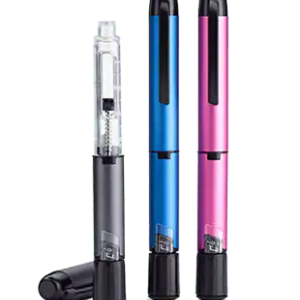
Medtronic InPen : Controller
Inpen connects to a mobile app and displays dosage information directly on a smart mobile device.
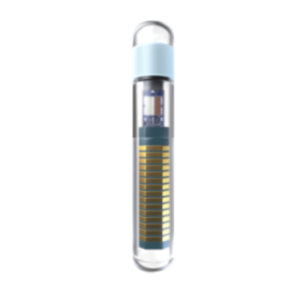
Eversense : Sensor
Professionally inserted by a physician during a medical visit. Minor procedure.
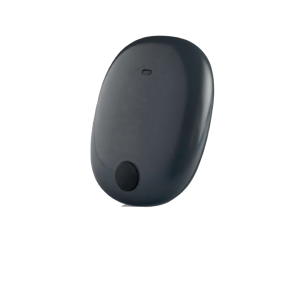
Eversense : Transmitter
Transmitter sits outside of the body and is held on by an adhesive. Sends data every 5 minutes to a connected mobile device.
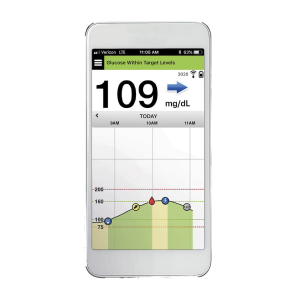
Eversense : Receiver
Real-time glucose measurements sent to a compatible mobile-device or smart watch. No need for a separate receiver. Available for both iOS and Android devices.
Device Details
Overview
Discreet and modern option for people using multiple daily injections.
Very small implantable sensor but large transmitter must be worn on top of the skin.
Affordability and Access
$$$$
Widely covered. InPen is covered by many insurance companies, typically users pay $50-$60 out-of-pocket copays for the one-year device. Prices range from $0- $549. For those without any insurance coverage, the pen's full price is $549.
$$$$
Sometimes covered. Insertion and removal require a Health Care Provider. Insertion costs $100-$300, and removal costs $100-$400. Sensor and transmitter cost $800-$1400.
Data Monitoring Options
Yes
Data can be easily shared with a healthcare provider or family members directly through the InPen app.
Yes
CGM data can upload automatically to the web-based Eversense data management system (EDMS) from the Eversense mobile app.
Data View Options
Yes
Data can be viewed on the InPen mobile app with dosage recommendations, glucose readings, and glucose trends.
Yes
Eversense mobile app receives and displays data in easy-to-read charts and graphs that can be shared with family and friends through the Eversense NOW app.
Duration and Storage
12-month pen 7-day sensor
Sensor lasts for 7 days, insulin pen lasts for up to 12 months with refillable cartridges, transmitter is rechargeable. Sensor can be stored between 36°F - 86°F and pens can be kept at room temperature.
365 Days
Sensor lasts 365 days, but a physician must implant it. Transmitter must be charged daily.
Vision / Auditory / Dexterity
NO text to speech
NO vibration alerts
A LOT of dexterity needed
YES text to speech
YES vibration alerts
SOME dexterity needed
Patient Considerations
Active Lifestyle
Light on body. Pens are easy to use and do not remain attached to the body, sensor is waterproof.
Water-resistant transmitter when submerged in 1 meter of water for up to 30 minutes and must be within 25 feet of the connected smart device.
Avoiding Highs and Lows
Limited customizability. System integrates the Guardian Connect CGM for high or low alerts but requires manual dose adjustment and limits the ability to adjust insulin levels throughout the day.
On-body vibration alerts when blood glucose levels are higher or lower than the set range. Trend arrows show the direction glucose is heading, with the rate of change.
Comfort
Many components. Have to carry InPen and pen needles. CGM is attached to the body and requires more tape than other sensors.
Longest-lasting sensor fits comfortably under the skin. Minor procedure is required. Least likely to have compression lows.
Easy Insulin Dosing
Dosing recommendations. Displays dosing recommendations and reminders for long-acting insulin.
Predictive alerts make insulin dosing easier by tracking high and low trends.
Easy to Use
Simple design. Replaces regular insulin pen. No additional devices to add on.
Minor procedure. Requires insertion by a physician during a medical visit.
Fewer Fingersticks
2 daily finger-sticks are needed to calibrate the sensor.
2 daily finger-sticks are needed to calibrate the sensor.
Privacy
Hideable. Pens are portable but visible when in use. Frequent injections are unavoidable. View recommendations and data on a smartphone.
Somewhat discreet. Tiny sensor is implanted under the skin, so the user can be discreet when needed. Ability to see sugar on watch or phone. Sensor not movable on body and requires regular meter use.